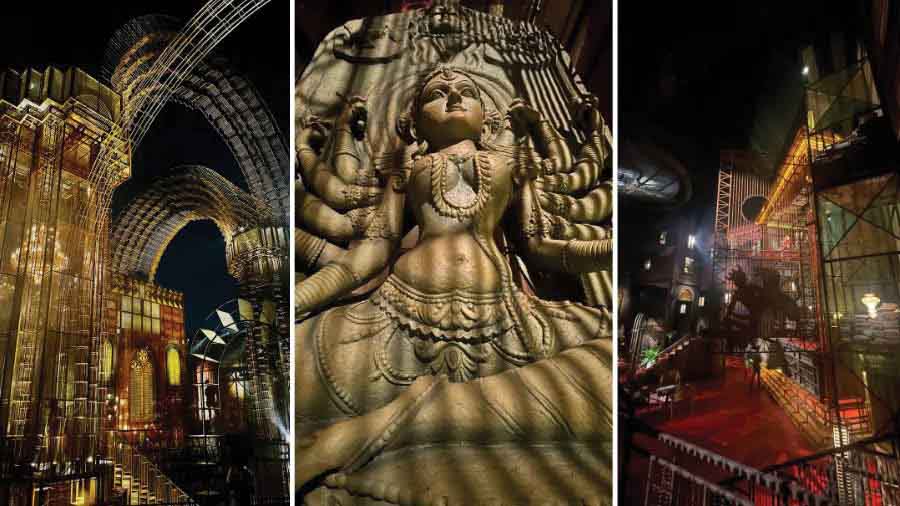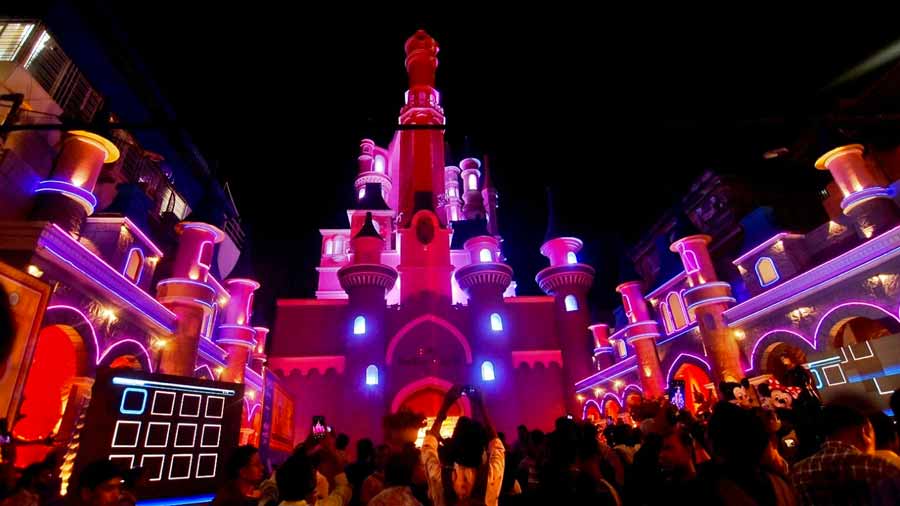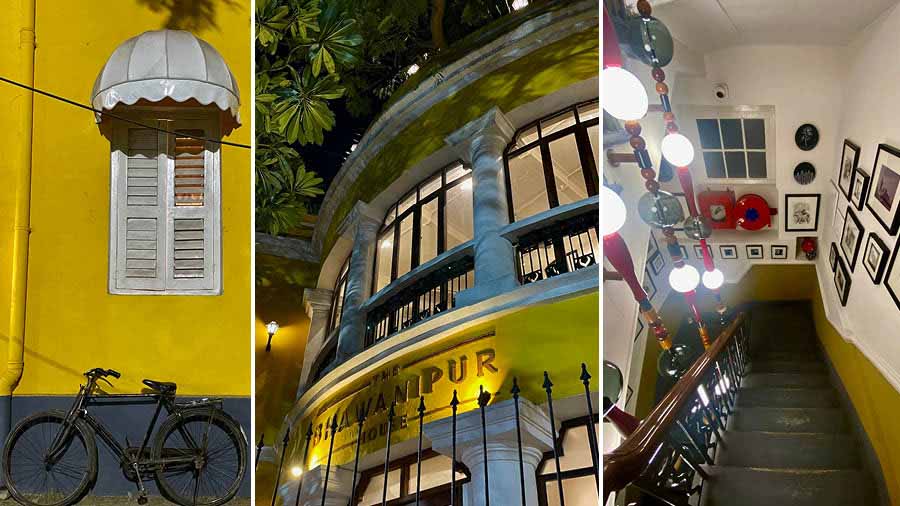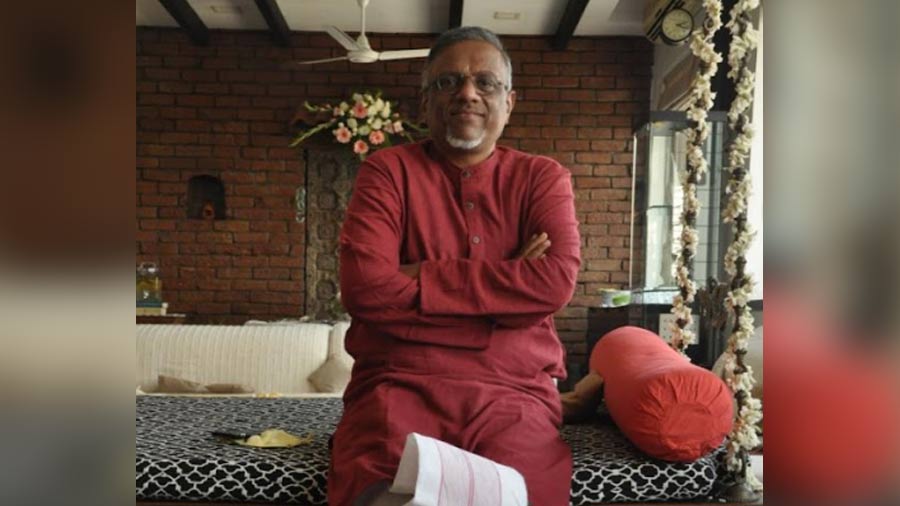Continued from here
Ten things that make the Tala Prattoy Durga Puja 2023 a game changer among pujas in Kolkata…
One: Tala Prattoy has to be possibly the most maverick Puja installation ever launched in Kolkata. Curator Susanta Paul has not taken his money and left; he has taken temporary residence inside the installation and exposed himself to public display. The result is that all those coming to see the Tala Prattoy Puja (TPP) will watch the protima with one eye and a sleeping Susanta on his four-poster bed — with an obese paashbaalish — with the other. They could be looking at the 80-foot chandelier installation with one eye and examining his roll-up study desk with the other. There is Susanta’s personal lounge with wrought iron garden furniture (“chaa-taa khaowar jonnye”), his 700-sq-ft washroom and his library — books on management, religion, architecture, films and history — with pictures of the great Tagore, and Rituporno Ghosh.
Susanta says people have asked him why he has a house in a Pujo installation. “Eta beshi hoye jay ni?, (isn’t it too much) they ask. My answer is that because this represents the presence of the divine in our personal life, space and existence. This power is not someone I seek in a temple or in a ritual. This divine power is present in my every moment, which explains the home inside the installation or vice versa, whichever way you look at it.”
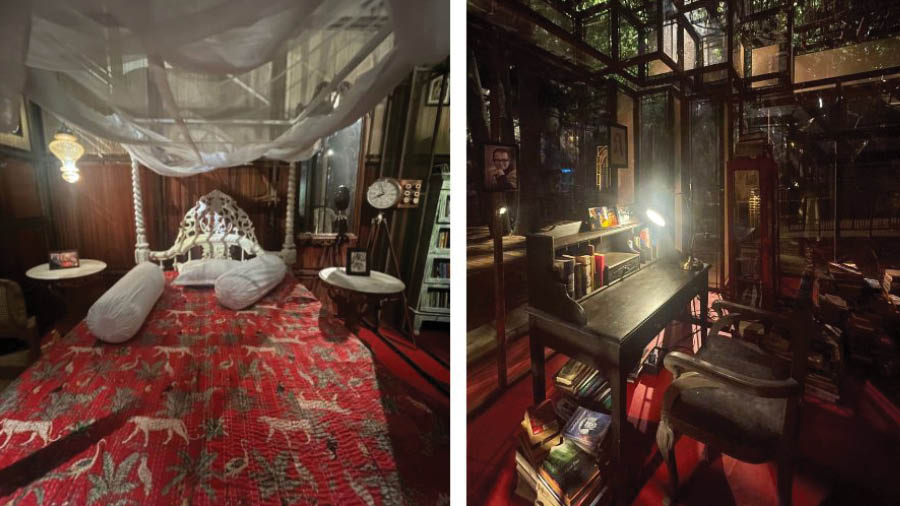
The four-poster bed with the ‘paashbaalish’, and (right) the study desk inside the Puja installation
In any other society, the audience would have baulked, and responded with “This is an opomaan (insult) of our great devi, maanchi naa aar maanbo naa (we won’t accept it)!” But Kolkata is different. It has given the curator a long rope on the grounds that each one has the right to interpret his or her relationship with the divine in a personal manner. If you subscribe to this sentiment, then the TPP is a daring attempt at testing the frontiers of divine worship with a new art installation idiom.
Two: The mood of the installation (I will not use the word pujo for reasons you will gather) is stylishly subdued. There are installation parts where it is difficult to see the face of a person 10 feet away. At the walking level, the lights are subdued to a point that there is a possibility that if one sits for 10 minutes in a corner, one could fall asleep. The curator is nudging the walker into tranquil consciousness, where it is possible to begin to contemplate the divine in the darkness to the exclusion of extraneous visual distractions, than if one were confronted with a 50-foot icon with 50 halogen lights torching into her. I like the irony. Most would call the latter traditional interpretation a Pujo and refer to TPP – nose screwed – as ‘aar ekta (one more) installation’.
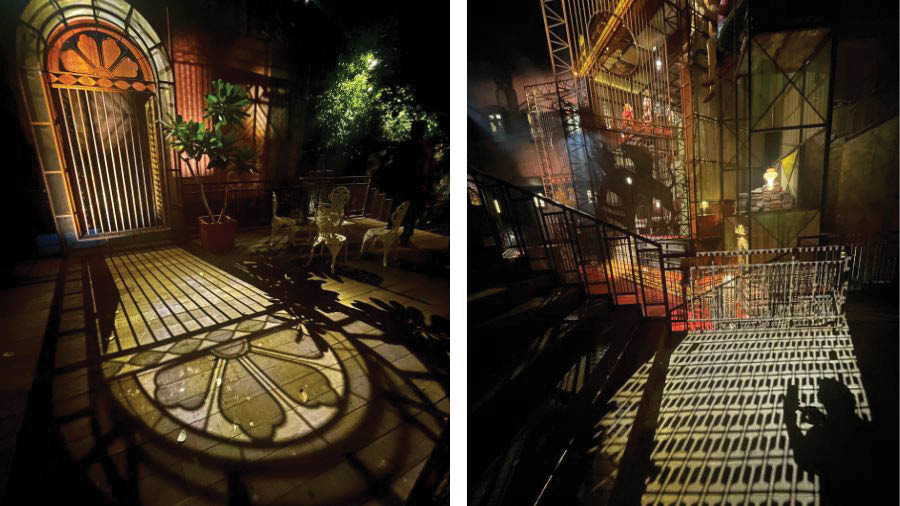
The mood of the installation is stylishly subdued, nudging the visitor into tranquil consciousness
Three: The curator softly unleashes his other weapon, sound. The first thing that struck me before I stepped inside the installation area was the sound quality and audibility. It is evident that the installation curator overcompensated with the sound system — not a means to communicate but to graduate the walker to a higher sensory level. I get the feeling of entering a large courtyard with rhythmic intonation, except that the usual human voice has been replaced by the specially curated, and not downloaded, alaap of a sarod, sitar, violin, oud, flute, sarangi and santoor, with no two instruments played concurrently. With this raw monotone in an installation with low visibility and high ceilings, I could have eased into savasana and entered my snore cycle in 253 seconds.
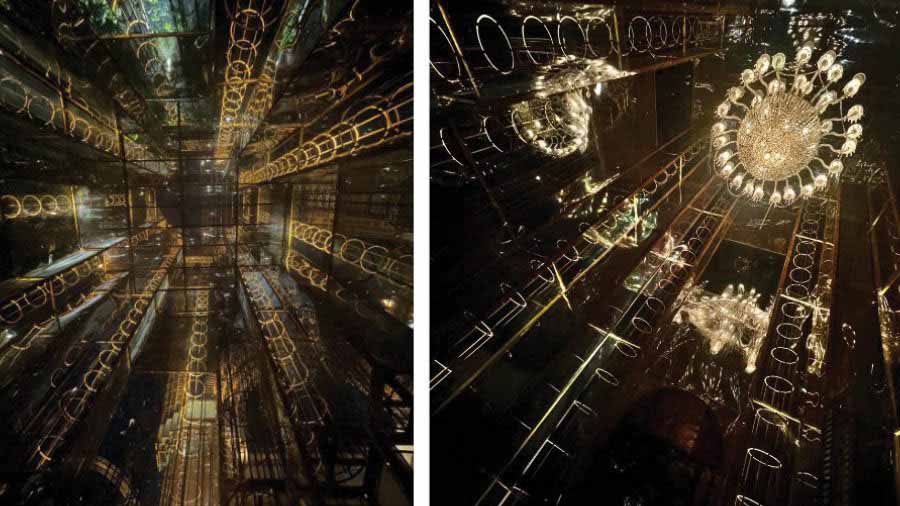
The installation is characterised by low lighting and high ceilings, with (right) an 80-foot chandelier
Four: At TPP, darkness is the principal mood creator. Susanta has employed darkness as a canvas. On this canvas, occasional light streaks have etched patterns. The result is that there are ‘shadow stories’ all over. I can visualise how Susanta’s mind may have worked, coupled with that of light curator Suman Maity: ‘we have this large space that we need interrupted alternatively by darkness and shadows, so that this may lead the visitor into specific directions,’ or ‘we need to integrate shadows into the flight of steps so that the person descending is compelled to look down and not miss a step,’ or ‘the shadow of the Natraj icon must be three times the actual so that the visitor may see the divine as not just a statue of a similar height but being larger than life,’ or ‘the intricate shadows (derived from finely cut metal shapes surrounding the Natraj) will not just be a mindless shadow play to tease visitors but to send out a message of thousands of sentient beings prostrating around the divine and eventually converging into it.’ If you are seeking a reason to visit this installation, then let this be the only one — the complex play of light and shade. This comprehensible visual grammar makes it possible to extend, imprint, dramatise and replicate shadows. Something as basic as the handrail of the garden bench is turned into a distinctive floor shadow. The alternative name for TPP should have been ‘The Art of Managing Darkness 2023’, provoking an international community raised on the Amsterdam Light Festival.
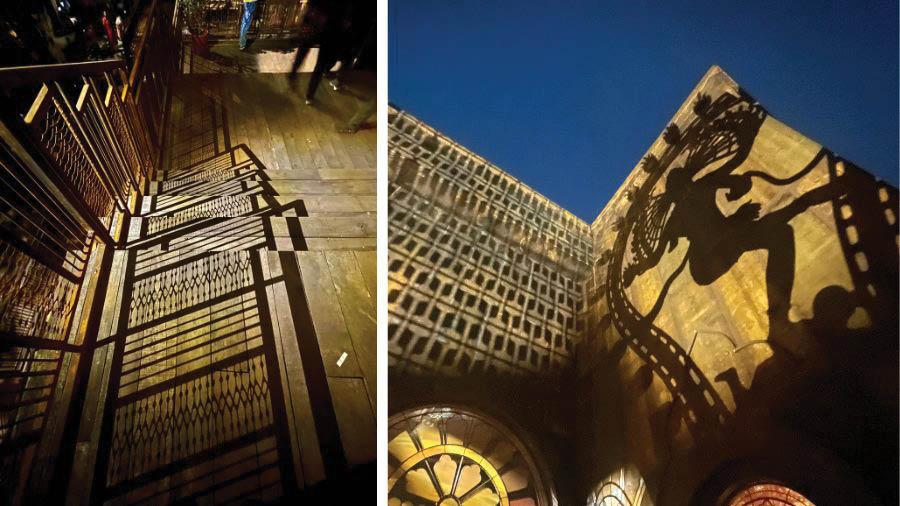
If there is one reason to visit the Tala Prattoy Puja, it is the complex play of light and shadow
Five: The central protima is a monotone grey, quite the colour of the clay it has been sculpted from. The first thing that strikes is the role of shadows on the devi’s frontal self — linear shadows run across her body except her face. Susanta got lucky. Someone from the fabrication team was opening a side grill for functional work a month ago when the light was switched on. For a moment, the vertical shadow streaks fell on the body of the protima without touching her face. Susanta froze; he asked the colleague to take a picture. This is how the protima would be displayed in the installation, he decided. As it turns out, the central protima is presented by TPP, shadows and all — probably the first time in my experience when the pristine divine has been depicted with silhouette lines running across herself.
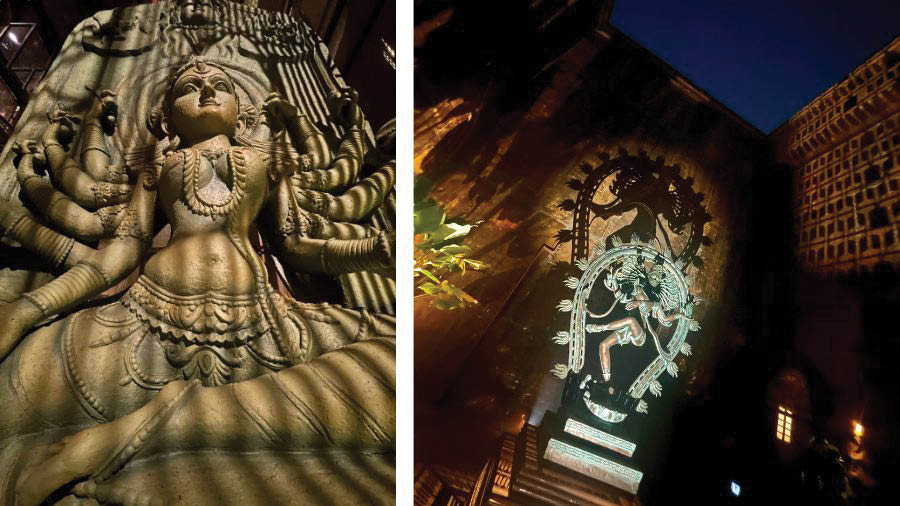
The Durga idol and (right) a Natraj installation — both showing off the creative play of shadows present throughout the pandal
Six: There are different levels in the installation, so what one experiences is not a linear display that accounts for only 30 per cent of the phone camera frame (unless one is zooming). What one gets with an unzoomed lens is a picture where every part of the frame has been ‘filled’ with structures across varying distances — one sub-installation back-ended by another, a less-lit structure back-ended by another one that is subtly lit. The result is a series of complex compositions. As a mobile phone photographer, I have a challenging time. Do I perceive and not just see? Can I angle the phone and get the installation to ‘speak’? Can I retreat two steps and get the shadow to ‘explode’? Any teacher of photography should WhatsApp a message to proteges: ‘Next class Tala Prattoy, 2am. Come with a back-up battery pack.’

The different levels of the installation create a stage for a masterclass in mobile phone photography
Seven: This TPP installation may not be a hall of mirrors, but Susanta has used coupling mirrors and polycarbonate sheets to create an effect of sorts. The result is that warm-toned lamps hanging from 40 feet reflect off plastic sheets being used as ‘walls’. Wasters like me can graduate from shooting the real, direct and the evident to prospect bewildering reflections — one can see through the transparent sheets onto the other side so there is nothing ‘boxed-in’. Susanta provides a philosophic spin, “The transparency is really a metaphor for the way one directly perceives and engages with the divine — no intermediary.”
Eight: There is virtually nothing in this installation that even hints that this could be the story of a daughter returning to her parental home, of divine power prevailing over the enemy, or of seeking cosmic grace. After 45 minutes of scrutiny, the only hint that this installation might have something to do with religion (apart from the protimas) is the arched rippled metal at the top of the installation. The arched design could have been the entrance of a temple or a masjid — and that is what makes this design interpretation different. I come back to what Susanta tells me, “Dada, this installation can only have been possible in Calcutta.”

The transparency (using the mirrors) is a metaphor for the way one engages with the divine — no intermediary, says curator Paul
Nine: I said “aabar bolun” when Susanta mentioned that 50,000 kgs of metal scrap had gone into this installation. I was happy to see that 190 workers who worked on the installation will be celebrated through their portraits and names mentioned in a separate sub-installation. I was surprised to find no Puja vinyl hoardings or arches or gateways either.
Ten: Susanta says that he wasn’t selected to curate the TPP on the basis of presentations or tenders; he was ‘appointed’ with the corresponding perquisites – no written brief, no formal proposal submission for approval, no budget clearance, no concept presented for committee review and no prescriptions like, “Susantababu, protimar mukh ta ektu change kore din, aapnar design cholbe na” (Mr Susanta, please change the face of the idol, your design will not work). Susanta repeats the two words that all us professionals salivate on — “Complete freedom.”
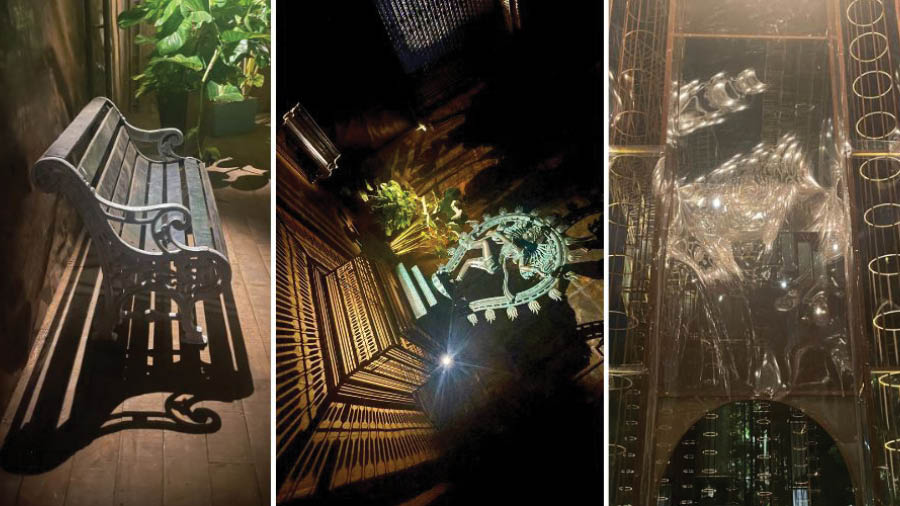
Susanta says that he wasn’t selected to curate the TPP on the basis of presentations or tenders but given ‘complete freedom’
I have a suggestion for the TPP committee. Retain the installation (minus the idol is my only concession) for at least a month so that Puja holidayers may use this as their first stop en route from the airport. Charge a fee to cover costs or donate, and run auto rickshaw services from the Belgachia Metro station to the installation site. Curate a book on how this installation was created and market this installation the worldover.
If more pujo committees showed similar chutzpah, the day is not far off when Kolkata Airbnb rooms are sold out even after charging rentals in dollars, doing for this city — by respect, confidence, visibility and incomes — what much of fresh industry capital has not in the last 12 years.
Okay, make that 46 years.
